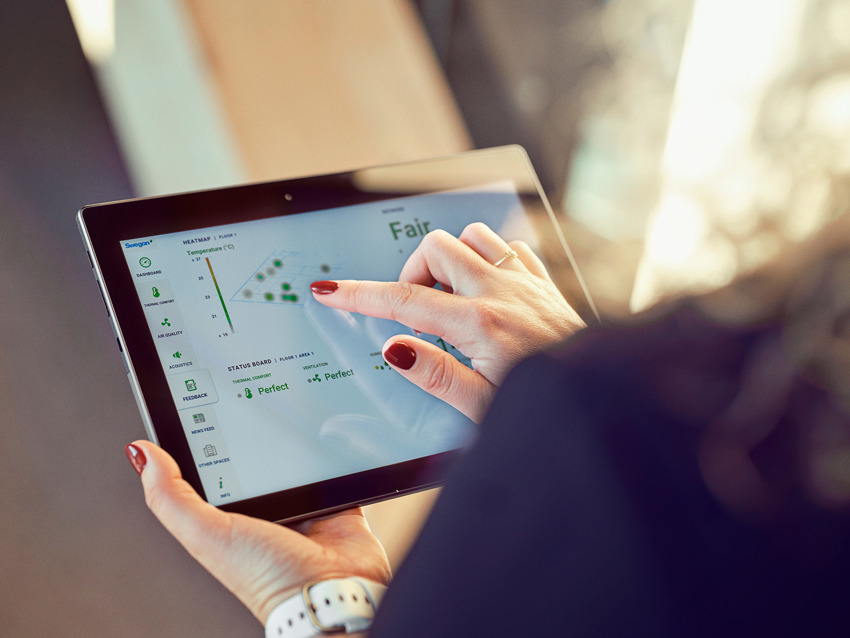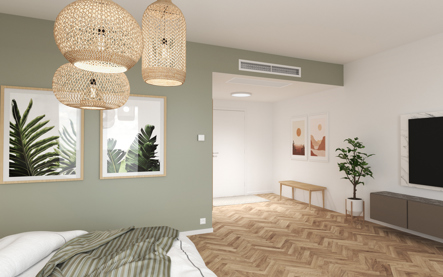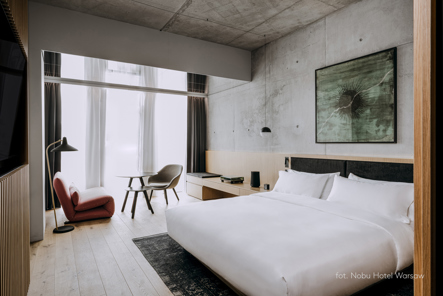The living spaces of a hotel
Historically, it was assumed that the indoor climate in the guest’s room was the most essential for a good hotel experience, but with the last few years in mind all living spaces in a hotel are crucial from a guest satisfaction perspective.
The hotel room is still the most obvious living space in a hotel, but many will also mention the restaurant, the lobby, the conference floor, a gym or a spa as primary places to spend time in in a hotel. The look and feel of all of these rooms and areas will influence the guests’ experience. A good experience will increase the chances of the guest returning, and also for him or her to spread a good word about the place.
Sources: Goldman, Michael (2021) 4 changes for hotels post-COVID I Nuel, Jean-Philippe (2021) Expert's voice: The intersections of tomorrow's hotel industry
Despite the role of a hotel, learn about sleep at Swegon Air Academy
Read more about the changes in the hotel industryThe indoor climate in a hotel
There are numerous different needs and demands to consider when creating a good indoor climate in a hotel. A basic understanding of which parameters affect the indoor environment quality (IEQ) and why, is a good start.
Architecture, design and careful choices of materials may be seen as central for a hotel, but none of these factors will make a positive impression on the guest unless the invisible aspects are considered too. Temperature, indoor lighting as well as day-light belong to the invisible, but imperative, factors. Not to mention sound, or noise. No duvet covers, soft pillows or curtains, wonderful day-spas or fantastic restaurants will be enough to convince any guest, overnighter or day-visitor, to return if the hotel is an acoustics nightmare. Guests will come back to, and recommend, a hotel that offers a comfortable temperature, that is silent and free from draught in all parts of the premises, especially in the hotelroom.
Learn more about the indoor climate factors
Read our expert's blog about IEQOur experts' thoughts about a hotel solution
Åsa Norén Lundh, manager for the Indoor Environment Competence Center at Swegon, and Ulf Hörman, responsible for business development of Swegon's System Solutions, were with their extensive experience in the field of HVAC asked to design a “napkin sketch” for a hotel. We are happy to share it with you here, but if you rather discover more about hotels in general, a number of different topics are found further below on this page.
A new way to travel for business
Companies across the world face a new reality in terms of business travel. Some employees are longing to travel again, others enjoy the digital work format. In many cases corporations have realised that travelling sometimes is excessive, both in terms of money and sustainability. A good reason to travel might therefore be needed, and in some cases the frequency of trips will be limited. A Deloitte survey shows that 68% of the asked executives will limit travel frequency due to the above.
A hybrid working model was born out of the pandemic. Trends propose that people who travel for business will also take the opportunity to work remote for a few days and enjoy the destination after office hours – travel for bleisure purposes. A hotel room may then be used for both work and leisure and it is reasonable to think that the preferences in regards to the indoor climate change throughout the day or stay. It is also expected that longer stays will make guests more insistent on a comfortable indoor environment.
Sources: Deloitte Insights (2021) Return to a world transformed I Kyriakou, Haritini (2021) The five trends shaping tomorrow's traveller
Performance and indoor climate
Hotels have generally offered various options for meetings and conferences. Today some companies see an opportunity in hotels offering professional office space that can allow their employees to perform quality work outside of the traditional office, or a busy home. A qualified office in this context does not necessarily have anything to do with a desk and a chair, but it for sure concerns the indoor climate.
Temperatures that run too high or too low make a noticeable impact on productivity, and the link between air quality and capacity to think strategically or learn is well established. Research shows that it is in general worth investing in a good indoor climate but that it is essential in offices and conference areas.
Sources: Nuel, Jean-Philippe (2021) Expert's voice: The intersections of tomorrow's hotel industry I Hickson, Helen (2021) Business travel has changed forever. What's next?
Learn more about air qualityEconomics and sustainability of a hotel
The most apparent revenue stream for a hotel is the room charge for one or more nights, but the fee for meeting rooms and the many services that are available to add to a conference package are significant too. Wining and dining is often of importance for a hotel and sometimes parking and other amenities can bring necessary incomes.
Looking at the hotel industry at the moment, a sincere focus on sustainability and overall reduced costs seem to make a noticeable economic difference. Luckily, energy efficiency is often a means to realise both.
Sources: Hertzfeld, Esther (2021) How smart technology can help hotels manage energy
Learn More
Technology developments to stay relevant
Hotels today must aim for a much higher level of technology to satisfy its guests. Many guests have been waiting for the breakthrough of online check-in and ordering of room service. Frequent travellers have longed for the opportunity to personalize their stay in terms of in-room lights, blinds, ventilation and more. Technology may also be seen from a bleisure-perspective. Meaning, people who go on leisure or business trips and combine it with each other may have different expectations on the indoor climate when getting ready in a suit ready for work or when staying in bed preparing for sightseeing.
Various digital services can allow guests to have the flexibility they are longing for, and at the same time enable the hotel to care for their guests and property. Many hotel management systems are possible to connect to todays digital services for HVAC.
Sources: Bishop, Tom (2021) Hotel design in a new landscape I Kyriakou, Haritini (2021) The five trends shaping tomorrow's traveller

